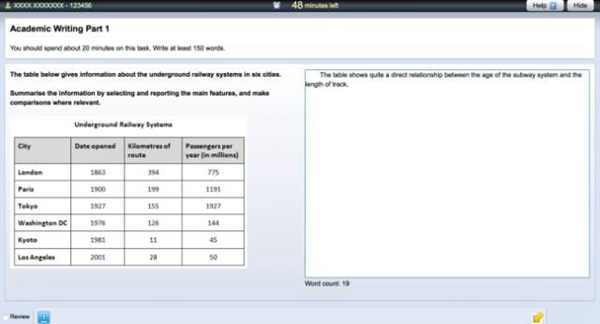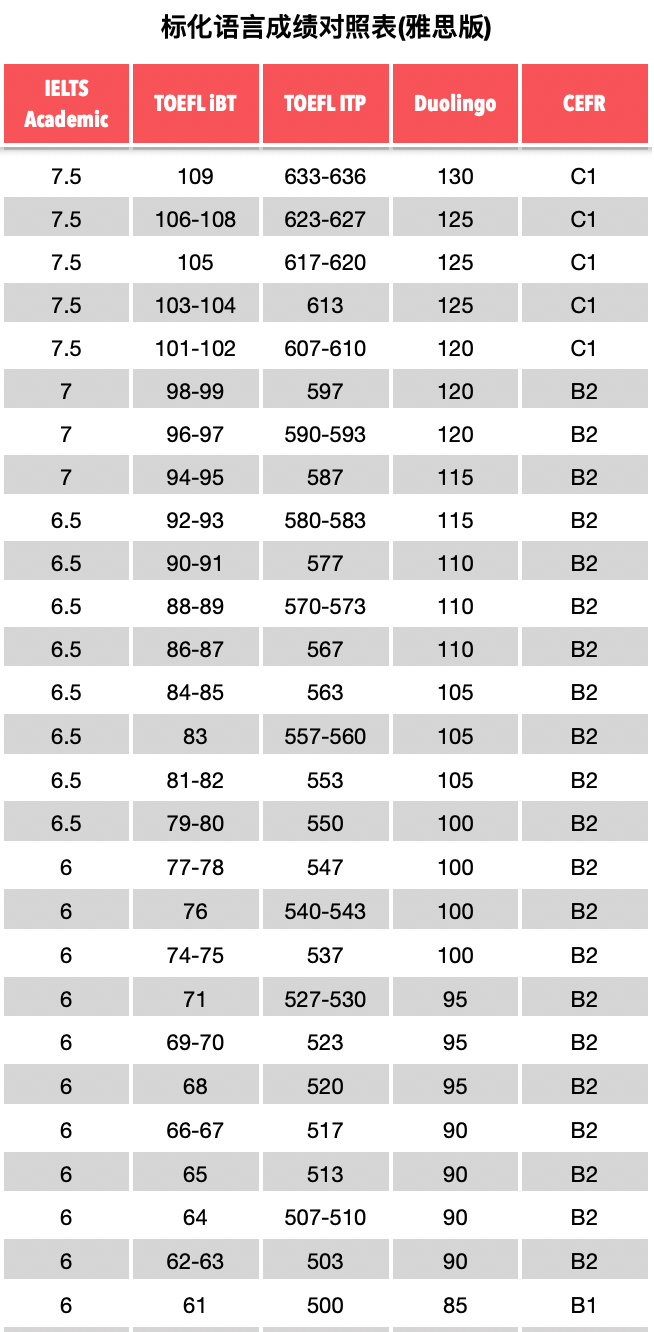今天小编给大家带来雅思机考写作考试实战经验分享,希望能够帮助到大家,下面小编就和大家分享,来欣赏一下吧。
雅思机考写作考试实战经验分享
关于写作
写作部分是个人体验最好的一个部分,考场键盘的打字舒适度较高,小作文的时候左边是图表,右边是写作空间,左右比对十分方便。下面实时的字数统计,也能很直观的检查到字数是否符合要求。
写作
完成阅读考试后,进入机考的最后一部分写作考试。和之前一样,监考人员会下发含有写作机考Password的A4雅思个人信息纸。考生在完成登陆后,即可看到下面这个页面:

点击Start test后进入Part 1小作文页面:

考生需要将答案写入屏幕右边的空格处,电脑会自动计算字数,并在左下角实时显示字数。大家的答案将被自动保存。考生可自行决定先完成哪个写作题目。 这道小作文样题来自剑雅5的Test 4。我在样题上做了一下给大家展示效果。这是我用空格键按了8下,写了第一句话之后:

屏幕右下方自动统计我写了19个字。 这是我的第一段,除第一句的信息交待,第二句我写的是全文最重要的一句话(Overview):
屏幕右下方自动统计共52个字。 这是小作文写完后的页面:

完成这篇小作文我一共写了170个字。 在纸笔考试中,对于分段,通常有两种方式:一种是缩进式(indented),每段话开头缩进4个字母,段与段之间不空行;另一种是齐头式(blocked),每段话开头顶格写,段与段之间空一行。当然,考生也可以缩进加空行,即每段话开头缩进4个字母,段与段之间空一行。 机考时,由于考生不需操心纸张不够,也不需因为写错了单词要划掉或用橡皮擦掉,完全可以使用第三种缩进加空行的方式。
Part2大作文
在考试最后10分钟和5分钟时,屏幕顶端的时间提醒将变红并闪烁。时间到,考试结束,出现此页面:
考试开始前,你需要做的是
每部分考试正式开始前,在监考人员宣读完机考注意事项后,下发包含有登陆username 和password的A4雅思个人信息纸。考生均需在监考人员指示下登陆考试系统。在登陆后,首先完成核对个人信息的关键一步,然后是阅读机考操作指南及完成屏幕设置,不能提前开始作答,否则将会视为违规。
(事实上,大家无法提前进入下一个步骤,因为同一考场的开始考试时间是统一的。即便点击了继续,也只会比其他人更早看见旋转的菊花而已。)
· Help选项:在每部分的考试全程中,屏幕右上方均会出现Help选项。考生可随时点击了解相关操作信息,包括页面功能键如何使用,每种题型答题操作方法等
· 屏幕设置:在每部分的考试全程中,大家均可随时点击屏幕右上方的设置选项,调整适合自己的文字大小和颜色,背景色及屏幕分辨率。
暂停考试:如需暂停考试离开考场,可点击屏幕右上方Hide Tab按钮隐藏屏幕。回到座位时,点击Resume Test选项即可继续考试。
· 时间管理:每个部分的考试中,大家均可在屏幕顶端看见以倒计时方式显示的时间,随时查询剩余的考试时间。在每部分考试最后10分钟和5分钟时,屏幕顶端的时间提醒将变红并闪烁。当时间完结时,考试将自动结束。
听力与阅读共同的答题操作指南
·3种题目之间跳转的操作方式:
1.点击屏幕底部导航栏Navigation Bar中的题号
2.点击屏幕右下方的“向右箭头”或“向左箭头”实现跳转或回看
3.使用键盘Tab键 (官方的机考Tutorial未提到,本人考试亲测可用
· 已完成题目的不同标记:在屏幕下方的导航栏的相应题号上会划出下划线。
· 方便考生检查的小功能:
点击屏幕左下方导航栏最左边的Review按钮做标记。此时,题目编号的形状会由方形变成圆形。大家可在考试结束前随时回看检查。(Review是帮助考生方便检查并不呈现在最后的答案中,不会影响你的得分。)
以上就是雅思机考写作考试实战经验分享的全部内容。从上文可以看出从纸笔考切换成雅思机考后,在考试流程上面还是有很多变化的。特别是在写作的这一个部分。如果考雅同学准备报考雅思机考的话,最好先了解一下雅思机考写作的流程和考过的同学的经验。
雅思阅读全真练习系列:Seeking an energy holy trinity
Seeking an energy holy trinity
1 NEELIE KROES, the European Union’s competition commissioner, did not mince her words when reporting on Europe’s energy markets on Wednesday January 10th. Europe’s energy firms have failed to invest in networks and so customers are suffering. Those “vertically integrated” energy companies such as Electricité de France (EDF) or Germany’s E.ON, widely dubbed as “national champions”, are effectively behaving like local monopolies. Shy of competition, eager for artificially high prices, they are helping to block the efficient generation, transmission and distribution of energy on the continent.
2 Energy prices vary wildly across Europe. Ms Kroes wants to see cheaper energy, and intends to push suppliers to divest their distribution network and to get them to invest more in transportation systems so that more energy—in the form of gas, or electricity, for example—can flow easily over borders. It is remarkably hard, for example, for gas-poor Germany to import from the neighbouring, gas-rich Netherlands. Companies that dominate national markets have, so far, had little interest in improving the interconnections which would mean lower prices for consumers across the continent.
3 Ms Kroes, of course, will struggle to get her way. The European Commission, which on the same day presented its recommendation for improving EU energy policy, also wants to see the unbundling of ownership, the legal separation of energy suppliers and transporters, something that the integrated energy companies and interested governments, notably in France and Germany, are bound to oppose ferociously.
4 Complicating the matter is an argument over the security of energy supply in Europe. Much has been made of the risk for western Europe of depending too heavily on Russian exports of gas. Russia under Vladimir Putin is prone to using energy exports as a blunt tool of foreign policy, especially when trying to bully countries in its hinterland. Last year Russia interrupted gas deliveries to Ukraine, affecting supplies in central and western Europe too. This week it blocked oil exports passing via Belarus to Europe, though that spat was soon resolved.
5 The risk is that concerns about security of supply may be used spuriously by those in Europe who oppose the sort of liberalisation encouraged by Ms Kroes. The likes of E.ON and EDF may claim that only protected national champions are able to secure supply, by striking long-term deals with powerful foreign suppliers. The Commission disagrees. Such deals are too often politically motivated and far from transparent. Protection has been tried for long enough and evidently has not worked for the internal market, nor have these companies secured the best deals for consumers from the Russians.
6 In contrast, the Commission's new policy proposes, ideally, a break-up of these companies into suppliers and distributors. (As a second best solution, especially for France and Germany, it recommends the management of the networks by a third party.) Properly independent managers of Europe's energy networks would have a strong incentive to build interconnecting pipelines and power lines across borders. For the gas market another means of ensuring competition and security would be finding a more diverse range of suppliers, for example by building more terminals for the import of liquified natural gas. It would also be likely to mean lower prices, if the example of liberalised Britain over the past ten years is anything to go by.
7 Whether any of this is likely to happen soon, however, is another matter. The Commission is also calling for European governments to agree on a common effort to reduce carbon emissions by at least 20% by 2020 (compared with 1990 levels). If America is willing to play ball, the Commission proposes to reduce emissions by as much as 30%. Achieving either target would mean promoting cleaner cars, a more effective emissions-trading system for Europe, wider use of public transport and a sharp increase in the use of renewable sources of energy, like wind and solar power. All that is laudable enough, but will also require political horse-trading as governments—Europe’s leaders are due to meet in March to discuss the various energy proposals—try to avoid commitments that may hurt domestic energy companies or make European firms less competitive than rivals in America, Asia and elsewhere.
(689 words)
Questions 1-5 Do the following statements reflect the views of the writer in the reading passage?
In boxes 1-5 on your answer sheet write
YES if the statement reflects the views of the writer
NO if the statement contradicts the views of the writer
NOT GIVEN if there is no information about this in the passage
1. Europe’s energy companies have funded the construction of the distribution network.
2. There has been a wide range of energy prices within Europe.
3. Gas-poor Germany has to pay a price higher than average to import gas from its neighbour.
4. E.ON and EDF may oppose the liberalisation due to their concerns about the security of energy supply.
5. The European Commission proposes to reduce carbon emissions by 30% if the U.S. is willing to cut its.
Questions 6-10 Look at the box of countries below.
Choose One or Two countries to complete the following sentences.
Write your answers in boxes 6-10 on your answer sheet.
Countries
A. Belarus
B. Britain
C. France
D. Germany
E. Russia
F. Ukraine
G. The U.S.
6. It’s dangerous for western Europe to depend too much on gas imports from ……
7. A liberalised policy of energy supply was enforced over ten years in …
8. Last year energy supplies in central and western Europe was affected owing to the interruption of gas deliveries to …
9. The governments in …… are bound to oppose the separation of energy suppliers and transporters?
10. Oil exports passing via … to Europe was blocked this week.
Questions 11-14
Choose NO MORE THAN THREE WORDS from the reading passage above for each answer.
Write your answers in boxes 11-14.
11. The EC disagrees with energy firms to strike long-term deals with foreign suppliers because such deals are usually far from …
12. The EC proposes to split those “national champions” into …
13. A more diverse range of suppliers would guarantee …in the European gas market.
14. The realization of carbon emissions reduction would require the promotion of cleaner cars, a better emissions-trading system, wider use of public transport and more use of … of energy.
雅思机考写作考试实战经验分享相关文章:
★ 托福雅思哪个更好考
雅思机考写作考试实战经验分享
上一篇:雅思托福的异同点和适用范围对比






